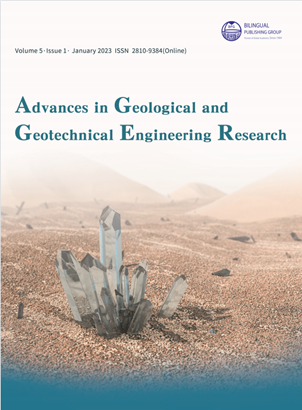-
148
-
147
-
131
-
124
-
117
Study on Epithermal Gold Mineralization System at Shwebontha Prospect, Monywa Copper-Gold Ore Field, Central Myanmar
DOI:
https://doi.org/10.30564/agger.v5i1.5230Abstract
The Shwebontha prospect area is situated in the Central Volcanic Belt, central Myanmar, where the well-known Sagaing Fault serves as its eastern boundary. This study aims to document key the mineralogy, host rock geochemistry and ore mineralizing fluids. The mineralization, hosted by Upper Oligocene to Middle Miocene rhyolites, displays a strong lithological control. Mineralization is characterized by gold-bearing silicified massive ore and chalcedonic quartz veins in which sulfides are clustered and disseminated not only in quartz gangue but also in rhyolite host rocks. The significant ore minerals in the mineralized veins include pyrite, sphalerite, galena, chalcopyrite, and gold. Common hydrothermal alterations such as silicic, argillic and propylitic alteration types are recognized. According to the fluid inclusion data and interpretation, ore mineralizing fluids in the research area are characterized by formation temperatures of 260-280 °C and salinity of 0.35-2.41 % wt. NaCl eq. respectively. Mixing of hydrothermal fluids was generally considered to be an effective mechanism for ore transport and deposition.
Keywords:
Geochemistry; Alteration; Fluid inclusions; Ore mineralization; Central Volcanic Belt, ShwebonthaReferences
[1] Mitchell, A.H.G., Myint, W., Lynn, K., et al., 2011. Geology of the high sulfidation copper deposits, Monywa mine, Myanmar. Resource Geology. 61, 1-29.
[2] Knight, J., Zaw, K. (editors), 2015. The geochemical and geochronological framework of the Monywa high sulfidation Cu and low sulfi dation Au-epithermal deposits, Myanmar. Poster No. 104 presented at the SEG, Conference; Hobart, Tasmania, Australia.
[3] Oo, T.N., Harijoko, A., Setijadji, L.D., 2021. Fluid inclusion study of epithermal gold-base metal mineralization in the shwebontha pros pect, Monywa Mining District, Central Myanmar. Journal of Applied Geology. 6(1), 1-16.
[4] Htet, W.T., 2008. Volcanic-hosted gold-silver mineralization in the Monywa mining district, central Myanmar [PhD thesis]. Myanmar: Mandalay University.
[5] Zaw, K., Swe, Y.M., Myint, T.A., et al., 2017. Copper deposits of Myanmar. Geological Society Memoir. 48, 573-588.
[6] Mitchell, A.H.G., Myint, T.H., 2013. The Mag matic Arc and Slate Belt: Copper–gold and tin–tungsten and gold metallotects in Myanmar. East Asia: Geology, exploration technologies and Mines extended abstracts. Bulletin (Australian
[7] Institute of Geoscientists). 57. Gardiner, N.J., Robb, L.J., Searle, M.P., 2014. The metallogenic provinces of Myanmar. Applied Earth Science. 123, 25-38.
[8] Zaw, K., 1990. Geological, petrological and geochemical characteristics of granitoid rocks in Burma: With special reference to the associated W-Sn mineralization and their tectonic setting. Journal of Southeast Asian Earth Sciences. 4, 293-335.
[9] Mitchell, A., Chung, S.L., Oo, T., et al., 2012. Zircon U-Pb ages in Myanmar: Magmatic-metamorphic events and the closure of a neo-Tethys ocean? Journal of Asian Earth Science. 56, 1-23.
[10] Searle, M.P., Noble, S.R., Cottle, J.M., et al., 2007. Tectonic evolution of the mogok metamorphic belt, Burma (Myanmar) constrained by U-Th-Pb dating of metamorphic and magmatic rocks. Tec-tonics. 26(3). DOI: https://doi.org/10.1029/2006TC002083.
[11] Swe, W. (editor), 1972. A Strike-slip faulting in central belt of Burma [abstr.]. Regional Confer ence on the Geology of SE Asia, Kuala Lumpur. Kuala Lumpur; Geological society of Malaysia Kuala Lumpur.p. 34, 59.
[12] Naing, M.M., 2003. Petrology and mineralization of Sabe, Kyisin and Letpadaung copper deposits, Monywa District, Central Myanmar [PhD thesis]. Mandalay: University of Mandalay.
[13] Mitchell, A.H.G., Asua, C., Deiparine, L. (editors), et al., 1999. Geological settings of gold districts in Myanmar. PACRIM 99 Congress; Bali, Indonesia. Australia: AusIMM.
[14] Bodnar, R.J., 1993. Revised equation and table for determining the freezing point depression of H2O NaCl solutions. Geochimica et Cosmo chimica Acta. 57(3), 683-684.
[15] Middlemost, E.A.K., 1994. Naming materials in the magma/igneous rock system. Earth Science Reviews. 37(1), 19-26.
[16] Winchester, J.A., Floyd, P.A., 1977. Geochemical discrimination of different magma series and their differentiation products using immobile elements. Chemical Geology. 20, 325-343.
[17] Irvine, T.N., Baraga, W.R.A., 1971. A guide to the chemical classification of the common volcanic rocks. Canadian Journal of Earth Sciences. 8, 523-548.
[18] Wilkinson, J.J., 2001. Fluid inclusions in hydro thermal ore deposits. Lithos. 55, 229-272.
[19] Burnham, C.W., 1979. Chapter 3: Magmas and hydrothermal fluids. Barnes, H.L. (editor), Geochemistry of hydrothermal ore deposits, 2nd edition. John Wiley & Sons Inc: New York. pp. 71-136.
[20] Hedenquist, J.W., Lowenstern, J.B., 1994. The role of magmas in the formation of hydrothermal ore deposits. Nature. 370, 519-527.
[21] Simmons, S.F., Brown, K.L., 2006. Gold in magmatic hydrothermal solutions and the rapid formation of a giant ore deposit. Science. 314, 288-291.
[22] Shepherd, T.J., Rankin, A.H., Alderton, D.H.M., 1985. A Practical Guide to Fluid Inclusion Studies. Blacie & Son Press: London.
[23] Hayba, D.O., Bethke, P.M., Heald, P., et al., 1985. Geologic, mineralogic, and geochemical characteristics of volcanic-hosted epithermal precious metal deposits. Reviews in Economic Geology. 2, 129-167.
Downloads
How to Cite
Issue
Article Type
License
Copyright © 2023 Toe Naing Oo, Agung Harijoko, Lucas Donny Setijadji

This is an open access article under the Creative Commons Attribution-NonCommercial 4.0 International (CC BY-NC 4.0) License.




 Toe Naing Oo
Toe Naing Oo





